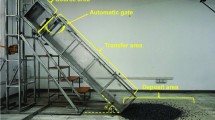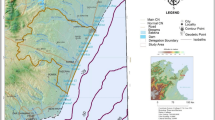Abstract
This study describes the application of a multipoint shape accel array to investigate the relationships between the slope displacement, precipitation, and groundwater level. Considering the displacement tangent angle (α) of the displacement–time curve for slopes, we examined the correlation between the slope displacement stages and precipitation. In addition, the threshold values of the slope displacement derived from previous studies were compared and transformed to improve the values of α. The average velocity of creeping in the slope was used as the displacement velocity in the uniform-velocity displacement stage. The results are as follows: (1) The driving displacement threshold value of the cumulative precipitation was approximately 300 mm before the construction of the catch pits, and increased to 500 mm thereafter. (2) A displacement velocity ratio of 8 can be used as an early warning index. (3) When the improved displacement tangent angle was larger than 70°, the slope displacement was in the attention stage; when the angle was larger than 85°, the slope displacement was in the alert stage, and when the angle was greater than 87°, the slope displacement was in the action stage. (4) The displacement velocity ratio is an arctangent function of the improved tangent angle. The displacement velocity ratio amplifies the difference between the stages when the accelerated displacement of the slope approaches the latter part of the critical stage.






















Modified from Wang et al. 2017, including this case)

Similar content being viewed by others
References
Central Weather Bureau (2009) “Earthquake Information” Taipei City, Taiwan. https://scweb.cwb.gov.tw/en-us/earthquake/details/EE2009121921021669144
Express Highway Research Foundation of Japan (1986, 1988), Research Report on dynamics observation for landslide construction in danger areas (Part 3), Japan Highway Public Corporation. (In Japanese)
Huang CS, Jeng CJ (2004) A supplementary geological survey and analysis of the Talun area around the Huafan University. J Art Des Huafan Univ 1:59–70
Japan Landslide Association for Slope Disaster Management (JAS-DiM) (1978) Essential Implementation of Technical Design for Land-slide Countermeasures 2:22, (in Japanese)
Jeng CJ (2019) Study on the design and construction and effects of catch pits applied in dip-slope countermeasure. Prof Eng J 87:63–72
Jeng CJ, Su DZ (2016) Characteristics of ground motion and threshold values for colluvium slope displacement induced by heavy rainfall: a case study in northern Taiwan. Nat Hazards Earth Syst Sci 16:1309–1321
Jeng CJ, Hung CS, Shieh CY (2008) “Case study of the application of in-situ geological mapping and 2D-resistivity image exploration for the slope in Huafan University” (in Chinese). J Art Des Huafan Univ 4:166–180
Jeng CJ, Yang CY (2015) A Case Study on variation in rainfall driving slop stability and remediation strategies. In: The 16th Conference on Current Researches in Geotechnical Engineering in Taiwan B39
Liao JT, Chen CW, Chi CC, Lin HH (2013) Study of slope displacement for management from landslide monitoring cases in Taiwan. Sino-Geotechn 136:59–70
Sun J (2007) Rock rheological mechanics and its advance in engineering applications. Rock Soil Mech 26(6):1081–1106
Tseng CH, Chan YC, Jeng CJ, Hsieh YC (2017) Slip monitoring of a dip-slope and runout simulation by the discrete element method: a case study at the Huafan University campus in northern Taiwan. Nat Hazards 89:1205–1225
Tseng CH, Chan YC, Jeng CJ, Rau RJ, Hsieh YC (2021) Deformation of landslide revealed by long-term surficial monitoring: a case study of slow movement of a dip slope in northern Taiwan. Eng Geol 284:106020
USBR (1987) Embankment Dam Instrumentation Manual. A Water Resources Technical Publication, Denver, CO. US Dept of the Interior, Bureau of Reclamation
Wang L, Xie M, Chai X (2014) Research on method of displacement speed ratio for spatial evaluation of landslide deformation. Rock Soil Mech 35(2):519–528
Wang X, Li G, Liu Y, Fu K (2017) Critical sliding prediction criterion of landslide based on uniform deformation rate. Rock Soil Mech 38(12):3670–3679
Xu Q (2020) Understanding the landslide monitoring and early warning: consideration to practical issues. J Eng Geol 28(2):360–374
Xu Q, Zeng YP, Qian JP, Wang CJ, He CJ (2009) Study on an improved tangent angle and the corresponding landslide pre-warning criteria. Geol Bull China 28(4):501–505
Xu Q (2011) “Early warning and emergency treatment of landslide disaster” The State Key Laboratory of Geohazard Prevention and Geoenvironment Protection (SKLGP), Chengdu University of Technology, An Academic Report on Sichuan Weekly Activity of National Chung Hsing University. (Private collection)
Yan Y, Wang S, Wang E (2010) Creep equation of variable parameters based on nishihara model. Rock Soil Mech 31(10):3025–3035
Funding
The authors have not disclosed any funding.
Author information
Authors and Affiliations
Corresponding author
Ethics declarations
Conflict of interest
The authors have not disclosed any competing interests.
Additional information
Publisher's Note
Springer Nature remains neutral with regard to jurisdictional claims in published maps and institutional affiliations.
Rights and permissions
About this article
Cite this article
Jeng, C.J., Chen, S.S. & Tseng, C.H. A case study on the slope displacement criterion at the critical accelerated stage triggered by rainfall and long-term creep behavior. Nat Hazards 112, 2277–2312 (2022). https://doi.org/10.1007/s11069-022-05265-3
Received:
Accepted:
Published:
Issue Date:
DOI: https://doi.org/10.1007/s11069-022-05265-3





